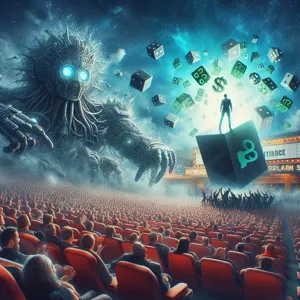In the ever-evolving landscape of cinema, the clash between blockbuster franchises and indie films has sparked a passionate debate about the very essence of storytelling on the big screen.
As massive studio productions dominate the box office with their high budgets, explosive action sequences, and star-studded casts, independent films quietly carve out their own space, often celebrated for their authenticity, innovative narratives, and emotional depth. This blog post delves into the heart of this cinematic showdown, exploring how both blockbusters and indie films contribute to the rich tapestry of film culture. We’ll examine the motivations behind these contrasting approaches, the audience they attract, and the impact they have on the future of filmmaking. Join us as we navigate this intriguing battle for cinema’s soul, uncovering what it truly means to be a storyteller in a world divided by spectacle and substance.
1. Introduction: Defining Blockbusters and Indie Films

In the ever-evolving landscape of cinema, the terms “blockbusters” and “indie films” evoke distinct images and emotions, often representing two opposing forces in the film industry. Blockbusters, with their hefty budgets, star-studded casts, and grand marketing campaigns, are designed to capture the attention of mass audiences. These films often feature high-octane action, dazzling special effects, and sweeping narratives that aim for universal appeal. Think of the latest superhero saga or a visually stunning fantasy epic; these films are engineered to dominate box offices and create cultural phenomena that resonate across demographics.
In stark contrast, indie films emerge from the vibrant underground of filmmaking, characterized by their lower budgets, experimental storytelling, and a focus on artistic expression over commercial viability. These films often delve into niche topics, personal stories, and unconventional narratives, inviting audiences to explore perspectives that mainstream cinema frequently overlooks. Indie filmmakers prioritize creativity and originality, often working with limited resources yet delivering profound and thought-provoking narratives that resonate deeply with viewers.
As we embark on this exploration of the cinematic realm, we will delve deeper into the defining characteristics, strengths, and weaknesses of both blockbusters and indie films. By examining the unique attributes of each, we can better understand their impact on the film industry and the audiences they serve. This battle for cinema’s soul is not merely about box office numbers; it is a reflection of our collective tastes, values, and the stories we choose to tell.
2. The Evolution of Cinema: How Blockbusters Emerged
The evolution of cinema is a fascinating journey marked by technological advancements, changing audience preferences, and the rise of powerful studios. In the early days of film, the art form was primarily defined by its experimental nature and independent spirit. Films were often short, silent, and created by passionate filmmakers with limited resources. However, as the industry began to mature, the demand for more elaborate storytelling and visual spectacle grew, paving the way for the blockbuster phenomenon.
The term “blockbuster” truly began to take shape in the 1970s, a transformative decade that saw the emergence of franchise filmmaking. This era gave birth to iconic films like “Jaws” (1975) and “Star Wars” (1977), which not only shattered box office records but also changed the way films were marketed and distributed. These films introduced the concept of the summer blockbuster, a strategic release period aimed at capitalizing on audience excitement and maximizing profits. With their hefty budgets and extensive marketing campaigns, studios discovered that they could create cinematic events that resonated with mass audiences, effectively turning movies into cultural touchstones.
As technology advanced, so too did the spectacle of cinema. The introduction of special effects, improved sound design, and stunning cinematography elevated the blockbuster experience, attracting viewers into theaters for the sheer thrill of the spectacle. The advent of CGI in the late 1990s and early 2000s allowed filmmakers to create visually stunning worlds that were once unimaginable, further solidifying the blockbuster’s place in contemporary cinema.
However, this shift towards high-budget productions has not come without consequences. The focus on profitability often overlooks the artistic risks that indie films are willing to take. While blockbusters dominate box offices and capture headlines, the indies continue to tell unique stories that challenge the status quo. As audiences seek a diverse range of narratives, the evolution of cinema raises important questions about the balance between commercial success and artistic integrity. The battle for cinema’s soul continues, with both blockbusters and indie films vying for their place in the hearts of moviegoers.
3. The Rise of Indie Films: A Brief History

The rise of indie films is a fascinating journey that has transformed the cinematic landscape, challenging the dominance of big-budget blockbusters and reshaping audience expectations. The term “independent film” refers to movies produced outside the major studio system, often characterized by lower budgets, creative storytelling, and a distinct artistic vision.
The roots of indie cinema can be traced back to the early 20th century, but it wasn’t until the 1960s and 1970s that it truly began to flourish. The countercultural movement of the ’60s gave birth to groundbreaking films like *Easy Rider* and *The Graduate*, which resonated with a generation seeking authenticity and innovation over the polished perfection of mainstream cinema. These films not only showcased new storytelling techniques but also encouraged filmmakers to explore unconventional themes and characters.
As the 1980s rolled in, the Sundance Film Festival emerged as a pivotal platform for indie filmmakers, providing them a space to showcase their work and connect with audiences and industry professionals. This festival became synonymous with indie film culture, launching the careers of directors like Quentin Tarantino and Kevin Smith, whose works, such as *Pulp Fiction* and *Clerks*, brought a fresh, irreverent voice to cinema.
The 1990s further solidified the indie film movement, with films like *The Blair Witch Project* and *Fight Club* achieving both critical acclaim and commercial success, demonstrating that independent films could not only tell compelling stories but also resonate with mainstream audiences. The advent of digital technology in the early 2000s democratized filmmaking, allowing aspiring filmmakers to create and distribute content more easily than ever before.
Today, indie films continue to thrive, showcasing diverse voices and innovative narratives that challenge traditional storytelling paradigms. With platforms like Netflix and Amazon Prime investing in original content, indie filmmakers now have unprecedented opportunities to reach global audiences. As audiences increasingly seek unique, heartfelt stories that reflect the complexities of modern life, the indie film movement stands as a testament to the enduring spirit of creativity and independence in cinema, reminding us that sometimes the most powerful stories come from those willing to take risks and forge their own path.
4. Financial Aspects: Budgeting and Box Office Dynamics
When it comes to the financial aspects of filmmaking, the stark contrast between blockbuster and indie films becomes evident. Blockbusters, often backed by major studios, typically boast astronomical budgets that can soar into the hundreds of millions. These films are designed not just to entertain but to dominate the box office, drawing in massive audiences with high-octane action, star-studded casts, and cutting-edge special effects. The financial stakes are high, and as a result, studios invest heavily in marketing campaigns that span global markets, ensuring that their films are everywhere—from billboards to social media feeds—long before they hit theaters.
In contrast, indie films operate on a shoestring budget, often relying on creative storytelling, innovative techniques, and powerful performances to captivate audiences. With budgets that can range from a few thousand to several million dollars, indie filmmakers must be resourceful, often funding their projects through a combination of private investors, crowdfunding, and grants. The financial model for indie films typically leans on niche appeal and critical acclaim rather than widespread commercial success. Many indie films aim for film festival circuits, where they can gain exposure and, ideally, secure distribution deals that allow them to reach broader audiences.
Box office dynamics further illustrate this divide. While a blockbuster may recoup its production costs within a weekend—thanks to expansive release strategies and international markets—indie films often rely on word-of-mouth and festival accolades to build momentum over time. Their success is measured not just by box office numbers but also by critical reception and audience engagement. A well-received indie film can achieve cult status, leading to long-term sales through streaming platforms and home video, often far exceeding its initial earnings.
This financial dichotomy shapes the narratives and creative choices of both types of films. Blockbusters are frequently crafted with a formulaic approach that guarantees mass appeal, while indie films thrive on originality and emotional depth. In this battle for cinema’s soul, the financial aspects serve as both a battleground and a canvas, highlighting the diverse ways stories can be told and experienced on the silver screen. As audiences continue to seek more varied cinematic experiences, the interplay between the high-stakes world of blockbusters and the intimate realm of indie films presents a fascinating examination of passion, artistry, and the economics of entertainment.
5. Audience Expectations: What Do Viewers Want?

In the ever-evolving landscape of cinema, audience expectations play a pivotal role in shaping the films that thrive in theaters. While blockbusters often dominate the box office with their high-octane action, stunning visual effects, and star-studded casts, indie films carve out their own niche by offering something uniquely raw and intimate. But what exactly do viewers want when they step into a darkened theater?
For many, the allure of a blockbuster lies in the promise of an exhilarating escape. Audiences crave spectacle—a thrilling ride that transports them to fantastical worlds, where they can revel in the excitement of superhero battles, epic space adventures, or sweeping historical dramas. These films deliver a sense of grandeur and excitement that’s hard to resist, often accompanied by a carefully crafted marketing campaign that builds anticipation long before the release date. Viewers know they can expect fast-paced storytelling, charismatic performances, and a satisfying resolution, designed to keep them on the edge of their seats.
On the flip side, indie films captivate audiences with their authenticity and emotional depth. These films often explore complex characters and intimate stories that resonate on a personal level, prompting viewers to reflect on their own lives and experiences. Audiences who gravitate toward indie cinema appreciate the artistry behind storytelling, the unique perspectives offered by emerging filmmakers, and the chance to support creative voices that challenge the status quo. They seek narratives that feel genuine and relatable, often favoring character development over spectacle.
The challenge for both blockbusters and indie films lies in meeting these diverse expectations. While blockbusters aim to satisfy the craving for entertainment and escapism, indie films strive to engage audiences on a more profound level, inviting them to connect with the characters and the themes presented. As viewers continue to evolve in their tastes and preferences, the battle for cinema’s soul intensifies, with both sides vying to capture the hearts and minds of moviegoers everywhere. Ultimately, the beauty of cinema lies in its ability to offer something for everyone, ensuring that whether you’re seeking thrills or introspection, there’s always a film waiting to fulfill your expectations.
6. Creative Freedom: The Differences in Storytelling Approaches
In the realm of filmmaking, creative freedom serves as a battleground where blockbusters and indie films demonstrate polarizing approaches to storytelling. Blockbusters, with their hefty budgets and corporate backing, often follow a tried-and-true formula that prioritizes mass appeal. These films are meticulously crafted to attract the widest audience possible, leading to high-stakes narratives filled with explosive action, grand special effects, and familiar tropes. The result is often a thrilling ride that delivers entertainment but can sometimes lack the depth or originality that cinema aficionados crave.
On the other hand, indie films thrive in the rich soil of creative autonomy. Filmmakers operating outside the confines of major studios are free to explore unconventional narratives, experiment with unique visual styles, and delve into complex character studies. This artistic liberty allows for innovative storytelling that often resonates on a more personal level with viewers. Indie films are known for their willingness to tackle niche topics, provide social commentary, or present stories from underrepresented perspectives that blockbuster films might overlook.
For instance, while a blockbuster might focus on a high-stakes superhero showdown to engage the masses, an indie film could delve into the quiet struggles of a single parent, weaving an intricate tapestry of emotions that reflects the human condition. This difference in storytelling approach not only shapes the narratives themselves but also influences how audiences connect with the films.
As we navigate this cinematic landscape, it becomes clear that both blockbusters and indie films have their own unique merits. Blockbusters offer exhilarating escapism, while indie films invite introspection and provoke thought. The real beauty lies in the diversity of storytelling, allowing cinema to remain a vibrant and multifaceted art form. In the end, it’s the interplay between these two worlds that keeps the heart of cinema beating, challenging traditional norms and pushing the boundaries of what film can be.
7. Marketing Strategies: How Blockbusters and Indies Promote Themselves

In the dynamic landscape of cinema, the marketing strategies employed by blockbuster films and indie productions reveal stark contrasts that reflect their differing objectives, budgets, and audience engagement tactics. Blockbusters, with their immense financial backing, often rely on a multi-faceted approach that saturates the market. They unleash a torrent of promotional materials—trailers, posters, and merchandise—ranging from eye-catching billboards in major cities to targeted ads on social media platforms. These campaigns often feature star-studded appearances on talk shows, viral marketing stunts, and partnerships with major brands to amplify their reach. The goal is to create an event around the film, generating buzz and anticipation long before the opening credits roll.
In contrast, indie films often operate on shoestring budgets, compelling them to be more creative and grassroots in their marketing efforts. Instead of competing for billboard space in Times Square, indie filmmakers lean into community engagement, using social media to cultivate a loyal fanbase. They often rely heavily on film festivals to create a buzz, leveraging the festival circuit as a launchpad for word-of-mouth promotion. Indie filmmakers might host intimate screenings, Q&A sessions with the cast and crew, and engage in direct conversations with their audiences online, fostering a sense of connection and authenticity that can resonate deeply.
Moreover, indie films often harness the power of storytelling in their marketing, focusing on the unique narratives and themes that set them apart from mainstream offerings. They may produce behind-the-scenes content or short documentaries that delve into the creative process, inviting audiences to invest emotionally in the film’s journey. This personal touch can create a passionate community of supporters who feel a vested interest in the film’s success.
Ultimately, while blockbusters aim for mass appeal through high-octane marketing strategies, indie films carve out their niche by fostering genuine connections and storytelling that resonates on a more personal level. Both approaches underscore the diverse tapestry of cinema, inviting audiences to engage with films in ways that reflect their own preferences and values. As the battle for cinema’s soul continues, the marketing strategies of blockbusters and indie films reveal not just their differences, but also the rich variety of experiences that film can offer.
8. Awards and Recognition: The Indie Film Circuit vs. Mainstream Awards
In the realm of cinema, awards and recognition serve as the golden ticket for filmmakers, often determining the trajectory of a film’s success and the careers of those involved. While blockbuster films consistently compete for the glitzy accolades of mainstream award ceremonies like the Oscars and Golden Globes, indie films navigate a vastly different circuit, vying for recognition in a world that values creativity and innovation over box office numbers.
Mainstream awards often spotlight the big-budget productions that dominate theaters, showcasing star-studded casts and high-octane marketing campaigns. These films frequently receive nominations in categories marked by their lavish production values and widespread popularity, often overshadowing smaller projects that may have a profound emotional or artistic impact. The pressure to conform to industry standards can lead to a homogenization of storytelling, where formulaic plots and familiar tropes reign supreme.
In contrast, the indie film circuit thrives on originality and authenticity, often celebrating stories that challenge societal norms and explore the human experience in innovative ways. Festivals like Sundance, Tribeca, and Cannes are sacred ground for indie filmmakers, offering a platform where their unique voices can be heard. Here, awards are not just about prestige; they symbolize validation for artists who dare to take risks and push artistic boundaries. Winning a coveted prize at such festivals can catapult a little-known filmmaker into the limelight, opening doors to opportunities that were previously out of reach.
However, the indie film journey is not without its challenges. While accolades can introduce these films to wider audiences, the competition is fierce, and recognition can often feel elusive. Many remarkable indie films may go unrecognized, their brilliance overshadowed by the industry’s fixation on blockbusters. Yet, the indie community remains resilient, thriving on the passion of its creators and the loyalty of its audiences, who appreciate the raw, unfiltered storytelling that often comes from smaller productions.
As the battle for cinema’s soul continues, the conversation around awards and recognition becomes increasingly significant. Are we valuing art for its commercial success, or are we nurturing the raw talent that brings depth and diversity to our screens? The answer may lie somewhere in the intersection of these two worlds, as both blockbusters and indie films contribute to the rich tapestry of cinematic storytelling. Ultimately, the future of cinema may depend on our willingness to celebrate the diverse narratives that emerge from both sides of the spectrum.
9. Cultural Impact: How Both Genres Shape Society
The cultural impact of blockbuster films and indie productions is profound, each shaping society in distinct yet equally significant ways. Blockbusters, often characterized by their massive budgets, high-octane action, and star-studded casts, dominate the global box office and generate widespread buzz. Their narratives, often steeped in universal themes of heroism, love, and adventure, resonate with audiences around the world, creating a shared experience that transcends geographical boundaries. These films often reflect and amplify prevailing societal values, contributing to the collective consciousness and setting trends in fashion, language, and lifestyle. They have the power to spark conversations about important issues, albeit often through a commercial lens.
On the other hand, indie films, with their intimate storytelling and unique perspectives, delve deeper into the human experience. They tackle niche topics and explore themes that are often overlooked by mainstream cinema. Through their focus on character-driven narratives and authentic portrayals of diverse lives, indie films challenge societal norms and provoke critical thought. They often provide a voice for marginalized communities, offering insights that encourage empathy and understanding. In this way, indie films can influence social change, inspiring audiences to question the status quo and consider alternative viewpoints.
While blockbusters may unite audiences in shared spectacle, indie films invite introspection and conversation. Together, they create a rich tapestry of cinematic expression that reflects the complexities of modern life. The interplay between these two genres not only entertains but also shapes societal attitudes, inspires movements, and fosters a greater understanding of the world around us. As we navigate through the multiplexes and art-house theaters, it becomes clear that both blockbusters and indie films are essential to the evolution of culture, each leaving an indelible mark on our collective psyche.
10. The Role of Streaming Services in Film Distribution
In the ever-evolving landscape of cinema, streaming services have emerged as powerful players, reshaping the way films are distributed and consumed. Once reserved for the occasional independent gem, these platforms now boast an extensive array of content, ranging from blockbuster hits to thought-provoking indie films. With just a few clicks, viewers can access a diverse library of films from the comfort of their homes, effectively democratizing film distribution.
Gone are the days when a film’s success hinged solely on its theatrical release. Streaming services like Netflix, Amazon Prime Video, and Hulu have revolutionized the traditional distribution model, offering filmmakers a viable alternative to the box office. Independent filmmakers, in particular, have found new opportunities to showcase their work to a global audience without the constraints of physical theaters. This shift has enabled unique voices and unconventional narratives to flourish, allowing audiences to explore stories that might otherwise remain hidden in the shadows of mainstream cinema.
Moreover, the role of streaming services extends beyond mere distribution. Many platforms now actively invest in original content, producing films that challenge the norms of conventional storytelling. By providing funding and creative freedom, these services empower filmmakers to push boundaries and explore topics that resonate with diverse audiences. This trend not only enriches the cinematic landscape but also fosters a more inclusive environment where indie films can thrive alongside their blockbuster counterparts.
However, this burgeoning relationship between streaming services and film distribution is not without its challenges. The sheer volume of content available can lead to viewer fatigue, making it difficult for indie films to gain traction amid the glitz and glamour of high-budget productions. Additionally, the emphasis on algorithms and viewer metrics can sometimes overshadow the artistry and intention behind a film, reducing it to mere numbers in a digital catalog.
As we navigate this new era of cinema, the role of streaming services continues to be a double-edged sword. They offer unprecedented access and opportunities for diverse storytelling while simultaneously presenting challenges that filmmakers must overcome to ensure their voices are heard. The battle for cinema’s soul rages on, with the lines between blockbusters and indie films becoming increasingly blurred, leaving audiences to ponder the future of film in this dynamic and rapidly changing landscape.
11. Viewer Experience: The Theater vs. Home Viewing Debate
The viewer experience has always been at the heart of the cinema debate, and in recent years, the stark contrast between the theater and home viewing has become a focal point in the Blockbusters vs. Indie Films conversation. For many, the thrill of watching a film on the big screen, surrounded by an audience immersed in the same story, is an experience that cannot be replicated at home. The grandeur of a blockbuster film demands the cinematic spectacle—the vibrant visuals, the heart-pounding sound, and the palpable energy that fills a packed theater. This communal experience amplifies the emotional highs and lows, as laughter, gasps, and applause become shared moments that linger in the memory long after the credits roll.
On the other hand, indie films often find their sweet spot in the intimate setting of home viewing. These films usually come with a more personal narrative, inviting viewers to reflect and engage in a deeper, often more contemplative manner. The comfort of home allows for an unhurried experience, where viewers can pause, rewind, and digest the storyline at their own pace. The accessibility of streaming services has made it easier for indie films, which may lack the marketing budget of their blockbuster counterparts, to reach audiences who appreciate their unique storytelling and artistic expression.
However, this convenience comes with a cost. The theater experience—complete with the smell of popcorn, the thrill of previews, and the shared gasps of the audience—fosters a sense of connection that is often missing during solitary viewing at home. The debate is not merely about the medium of delivery; it’s about the essence of how stories are told and experienced. As audiences continue to navigate these differing viewing environments, the question remains: will the allure of the theater prevail, or will the comfort of home viewing redefine cinematic engagement for a new generation? Each choice offers its own unique set of advantages and challenges, ultimately shaping the future of cinema in profound ways.
12. Case Studies: Iconic Blockbusters and Influential Indie Films
In the ever-evolving landscape of cinema, both blockbusters and indie films have carved out their own unique niches, each contributing significantly to the cultural dialogue and artistic expression of our time. To understand the contrasting yet complementary forces at play, let’s delve into some iconic case studies that exemplify the distinctive qualities of these two cinematic worlds.
**Iconic Blockbusters: “Avatar” (2009)**
James Cameron’s “Avatar” stands as a towering example of blockbuster filmmaking, not only for its staggering box office success but also for its groundbreaking use of technology. The film’s intricate visual effects and immersive 3D experience redefined what audiences could expect from a cinematic spectacle. “Avatar” isn’t just a visual feast; it weaves a narrative rich in themes of environmentalism and indigenous rights, prompting viewers to reflect on their relationship with nature. Its cultural impact extended beyond the screen, inspiring discussions around sustainability and corporate responsibility, demonstrating that blockbusters can deliver profound messages while captivating mass audiences.
**Influential Indie Films: “Moonlight” (2016)**
In contrast, Barry Jenkins’ “Moonlight” serves as a beacon of indie filmmaking, showcasing the power of personal storytelling. This Academy Award-winning film explores the complexities of identity, masculinity, and love through the life of a young Black man growing up in Miami. Its intimate portrayal of vulnerability and self-discovery resonates deeply with audiences, often leaving a lasting emotional impact. “Moonlight” highlights the artistic freedom that indie films possess, allowing for nuanced narratives that might be overlooked in the mainstream. The film’s success, both critically and at the box office, reinforces the idea that powerful storytelling can arise from small budgets and unique voices.
**Bridging the Divide**
These case studies reveal that both blockbusters and indie films serve essential roles in the cinematic ecosystem. While blockbusters often provide escapism on a grand scale, indie films challenge conventions and invite introspection. As audiences navigate the vast array of cinematic offerings, they are presented with opportunities to engage with diverse perspectives and narratives, enriching their understanding of the world around them. This interplay between the commercial and the artistic is what ultimately keeps the soul of cinema alive, fostering a landscape where every voice has the potential to resonate.
13. The Future of Cinema: Trends and Predictions for Both Genres
As the world of cinema continues to evolve, the conversation around blockbusters and indie films is more relevant than ever. Audiences are shifting, technology is advancing, and the ways in which we consume films are transforming. Understanding the future trends and predictions for both genres is crucial for filmmakers, industry professionals, and viewers alike.
Blockbusters, with their massive budgets and star-studded casts, will likely continue to dominate the box office, but this dominance comes with a caveat. As streaming platforms proliferate, the expectation of accessibility and immediacy grows. Audiences are increasingly drawn to the convenience of at-home viewing, yet the spectacle of a blockbuster experience—grand visuals, immersive sound, and communal viewing—remains a compelling draw. In response, studios may invest more in hybrid releases, where films premiere in theaters while also being available for streaming, allowing fans to choose their preferred viewing experience.
On the flip side, indie films are experiencing a renaissance fueled by advancements in technology that democratize filmmaking. With affordable equipment and editing software, aspiring filmmakers can produce high-quality content without the constraints of traditional financing. This accessibility encourages diverse storytelling that resonates with niche audiences, often bringing unique perspectives and innovative narratives to the forefront. As audiences crave authenticity and originality, indie films are expected to flourish, carving out their own space amidst the glitz of hollywood blockbusters.
Moreover, the rise of social media and digital marketing has enabled indie films to find their audience more effectively. Filmmakers can build passionate communities around their projects long before they hit theaters, leveraging platforms like Instagram, TikTok, and YouTube to create buzz and generate interest. This grassroots approach fosters loyalty and engagement, inviting viewers to be part of the filmmaking journey.
As we look to the future, a possible trend could emerge where the boundary between blockbusters and indie films blurs. Collaborations between major studios and indie filmmakers could yield fresh, innovative projects that maintain the grandeur of blockbuster storytelling while embracing the raw authenticity of independent cinema. This fusion might attract a wider audience, appealing to those who seek both spectacle and substance.
In conclusion, the future of cinema lies in its ability to adapt and evolve. Whether through the lens of a blockbuster or the intimate storytelling of indie films, the cinematic landscape will continue to thrive as it embraces new technologies, changing audience preferences, and a broader spectrum of voices. The battle for cinema’s soul is not just a clash of genres; it is a celebration of creativity, innovation, and the endless possibilities that lie ahead.
14. Conclusion: Finding Balance in a Diverse Film Landscape
As we draw the curtain on our exploration of the cinematic landscape, it becomes clear that both blockbusters and indie films serve vital roles in shaping the industry and enriching our cultural experience. The allure of big-budget productions, with their grand spectacles and star-studded casts, captures the imagination and draws massive audiences into theaters. These films, often backed by extensive marketing and distribution networks, dominate box offices and define popular culture, pushing the boundaries of technology and storytelling in ways that leave us awestruck.
Conversely, indie films breathe life into the industry with their raw authenticity and innovative narratives, often tackling themes that resonate on a personal level. These lower-budget gems are crafted with passion and creativity, giving voice to diverse perspectives and allowing filmmakers the freedom to explore unconventional ideas without the constraints of mainstream expectations. They invite audiences to engage with stories that challenge, inspire, and provoke thought, often creating a deeper emotional connection.
In this battle for cinema’s soul, the question is not which camp will emerge victorious, but rather how we can find a harmonious balance between the two. As audiences, we hold the power to support a diverse array of films—embracing the thrill of the blockbuster while simultaneously championing the artistry of indie projects. By attending film festivals, engaging with independent cinema, and encouraging conversations around lesser-known films, we contribute to a richer, more dynamic film culture.
Ultimately, the future of cinema lies in its diversity. A thriving film landscape should not be one defined by clear-cut divisions but rather one that celebrates the coexistence of grand spectacles and intimate narratives. In championing both blockbusters and indie films, we enrich our viewing experiences and ensure that the heart of cinema beats vibrantly, reflecting the myriad stories and voices that make our world so beautifully complex. As we leave the theater, let’s carry with us the appreciation for both forms, ensuring that we continue to support the filmmakers who dare to dream, whether their visions are grand or understated.
15. Call to Action: Supporting Indie Films in a Blockbuster World
In a cinematic landscape increasingly dominated by blockbusters with massive budgets and global marketing campaigns, supporting indie films has never been more crucial. These smaller productions often come from passionate storytellers who dare to challenge the status quo, exploring unique narratives and diverse voices that big studios may overlook. As a film enthusiast, you hold the power to influence the future of cinema.
Here’s how you can make a difference: first, consider attending local film festivals or screenings that highlight independent films. Not only will you discover hidden gems, but you’ll also engage with fellow cinephiles and support the filmmakers directly. Many indie films thrive on grassroots marketing and word-of-mouth, and your enthusiasm can help propel them into wider recognition.
Additionally, consider streaming platforms that prioritize indie content. Subscribing to services that showcase independent filmmakers can provide them with the financial support they need while giving you access to fresh and innovative cinema. Share your favorites on social media, write reviews, and encourage friends and family to watch. The more buzz you create, the better chance these films have to reach a larger audience.
Moreover, consider supporting crowdfunding campaigns for upcoming indie projects. Many filmmakers rely on platforms like Kickstarter or Indiegogo to fund their visions. By contributing, you not only help bring new stories to life but also become part of a community that values creativity and originality over formulaic plots and predictable sequels.
Finally, engage with your local independent theaters. These venues often offer a rotating selection of indie films and provide a space for community discussions and events. By choosing to watch films in these settings rather than the multiplex, you send a clear message that indie films matter and deserve a place in the cinematic conversation.
In a world where the blockbuster reigns supreme, your support for indie films can help preserve the soul of cinema. Every ticket purchased, every shared post, and every conversation sparked about an indie film contributes to a richer, more diverse film culture. So, take action today and champion the creators who dare to dream differently. After all, it’s in the independent spirit that the true magic of cinema often resides.
In conclusion, the ongoing battle between blockbusters and indie films is not just a clash of genres but a profound reflection of cinema’s evolving identity. While blockbusters captivate audiences with their visual spectacle and mass appeal, indie films serve as a vital counterbalance, offering unique narratives and artistic authenticity that resonate on a personal level. Both forms of filmmaking contribute richly to the cinematic landscape, pushing boundaries and challenging conventions. As viewers, we are fortunate to have access to a diverse array of stories that cater to different tastes and perspectives. Ultimately, it is this diversity that enriches our moviegoing experience and keeps the spirit of cinema alive. So the next time you settle into your seat, whether for a grand blockbuster or a thought-provoking indie feature, remember that each film plays a crucial role in the vibrant tapestry of storytelling that defines our shared cultural experience.






